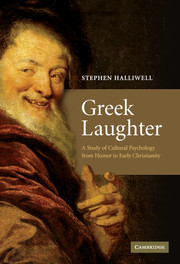Book contents
- Frontmatter
- Contents
- Preface
- Note to the reader
- Abbreviations
- 1 Introduction: Greek laughter in theory and practice
- 2 Inside and outside morality: the laughter of Homeric gods and men
- 3 Sympotic elation and resistance to death
- 4 Ritual laughter and the renewal of life
- 5 Aischrology, shame and Old Comedy
- 6 Greek philosophy and the ethics of ridicule
- 7 Greek laughter and the problem of the absurd
- 8 The intermittencies of laughter in Menander's social world
- 9 Lucian and the laughter of life and death
- 10 Laughter denied, laughter deferred: the antigelastic tendencies of early Christianity
- Appendix 1 The Greek (body) language of laughter and smiles
- Appendix 2 Gelastic faces in visual art
- Bibliography
- Index of selected authors and works
- Index of selected Greek terms
- General index
Appendix 2 - Gelastic faces in visual art
Published online by Cambridge University Press: 22 September 2009
- Frontmatter
- Contents
- Preface
- Note to the reader
- Abbreviations
- 1 Introduction: Greek laughter in theory and practice
- 2 Inside and outside morality: the laughter of Homeric gods and men
- 3 Sympotic elation and resistance to death
- 4 Ritual laughter and the renewal of life
- 5 Aischrology, shame and Old Comedy
- 6 Greek philosophy and the ethics of ridicule
- 7 Greek laughter and the problem of the absurd
- 8 The intermittencies of laughter in Menander's social world
- 9 Lucian and the laughter of life and death
- 10 Laughter denied, laughter deferred: the antigelastic tendencies of early Christianity
- Appendix 1 The Greek (body) language of laughter and smiles
- Appendix 2 Gelastic faces in visual art
- Bibliography
- Index of selected authors and works
- Index of selected Greek terms
- General index
Summary
The presence and/or significant absence of laughter and smiles in ancient Greek visual art prompts some intriguing questions. This appendix will broach these questions without attempting a comprehensive art-historical enquiry. My orientation will be towards themes and arguments developed elsewhere in the book.
An immediate caveat. In dealing with single images, it is often intrinsically difficult to distinguish between facial configurations of laughing and smiling. Both can involve an open and/or retracted mouth, with the muscles of the cheeks and around the eyes contracted and sometimes (more so with laughter than smiles) the upper teeth, less frequently the lower, exposed. Since, moreover, real laughter and smiles can succeed one another in rapid, blurred sequence, a ‘frozen’ image of a face (even in a photograph) may make a definitive choice between the two expressions impossible. In the most explosive kind of laughter the mouth ‘gapes’ (the force of the Greek verb χάσκειν) in a way which is never the case with smiling. But depicting such laughter seems not to have appealed to ancient Greek artists: we know nothing from antiquity to match, say, the wide open mouth of uproarious laughter portrayed in a remarkable ink drawing of Leonardo's, or the features of extreme mirth found in some of Hogarth's works. An alternative might be to show an overall bodily ‘profile’ of laughter, with (say) head thrown back and perhaps arms raised. (The suitors' uncontrolled hilarity at Hom. Od. 18.100 is a striking literary vignette of such whole-body convulsion.
- Type
- Chapter
- Information
- Greek LaughterA Study of Cultural Psychology from Homer to Early Christianity, pp. 530 - 552Publisher: Cambridge University PressPrint publication year: 2008



